Samenvatting
Summary Introduction to cognitive behavioral therapies - all the articles
- Instelling
- Rijksuniversiteit Groningen (RuG)
Summary for the course 'Introduction to cognitive behavioral therapies' . This summary contains all the articles that need to be studied for the exam. Note: for a summary of the book of Farmer & Chapman (Behavioral interventions in cognitive behavior therapy) of , see my other advertisement!
[Meer zien]







